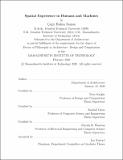| dc.contributor.advisor | Terry Knight and Randall Davis. | en_US |
| dc.contributor.author | Zaman, C̦ağrı Hakan. | en_US |
| dc.contributor.other | Massachusetts Institute of Technology. Department of Architecture. | en_US |
| dc.date.accessioned | 2021-02-19T20:36:00Z | |
| dc.date.available | 2021-02-19T20:36:00Z | |
| dc.date.copyright | 2020 | en_US |
| dc.date.issued | 2019 | en_US |
| dc.identifier.uri | https://hdl.handle.net/1721.1/129880 | |
| dc.description | Thesis: Ph. D. in Architecture: Design and Computation, Massachusetts Institute of Technology, Department of Architecture, February, 2019 | en_US |
| dc.description | Cataloged from student-submitted thesis. | en_US |
| dc.description | Includes bibliographical references (pages 215-224). | en_US |
| dc.description.abstract | Spatial experience is the process by which we locate ourselves within our environment, and understand and interact with it. Understanding spatial experience has been a major endeavor within the social sciences, the arts, and architecture throughout history, giving rise to recent theories of embodied and enacted cognition. Understanding spatial experience has also been a pursuit of computer science. However, despite substantial advances in artificial intelligence and computer vision, there has yet to be a computational model of human spatial experience. What are the computations involved in human spatial experience? Can we develop machines that can describe and represent spatial experience? In this dissertation, I take a step towards developing a computational account of human spatial experience and outline the steps for developing machine spatial experience. | en_US |
| dc.description.abstract | Building on the core idea that we humans construct stories to understand the environment and communicate with each other, I argue that spatial experience is a type of story we tell ourselves, driven by what we perceive and how we act within the environment. Through two initial case studies, I investigate the relationships between stories and spatial experience and introduce the anchoring framework --a computational model of constructing stories using emergent spatial, temporal, and visual relationships in perception. I evaluate this framework by performing a visual exploration study and analyzing how people verbally describe environments. Finally, I implement the anchoring framework for creating spatial experiences by machines. I introduce three examples, which demonstrate that machines can solve visuo-spatial problems by constructing stories from visual perception using the anchoring framework. | en_US |
| dc.description.abstract | This dissertation contributes to the fields of design, media studies, and artificial intelligence by advancing our understanding of human spatial experience from a story perspective; providing a set of tools and methods for creating and analyzing spatial experiences; and introducing systems that can understand the physical environment and solve spatial problems by constructing stories. | en_US |
| dc.description.statementofresponsibility | by C̦ağrı Hakan Zaman. | en_US |
| dc.format.extent | 224 pages | en_US |
| dc.language.iso | eng | en_US |
| dc.publisher | Massachusetts Institute of Technology | en_US |
| dc.rights | MIT theses may be protected by copyright. Please reuse MIT thesis content according to the MIT Libraries Permissions Policy, which is available through the URL provided. | en_US |
| dc.rights.uri | http://dspace.mit.edu/handle/1721.1/7582 | en_US |
| dc.subject | Architecture. | en_US |
| dc.title | Spatial experience in humans and machines | en_US |
| dc.type | Thesis | en_US |
| dc.description.degree | Ph. D. in Architecture: Design and Computation | en_US |
| dc.contributor.department | Massachusetts Institute of Technology. Department of Architecture | en_US |
| dc.identifier.oclc | 1237121644 | en_US |
| dc.description.collection | Ph.D.inArchitecture:DesignandComputation Massachusetts Institute of Technology, Department of Architecture | en_US |
| dspace.imported | 2021-02-19T20:35:29Z | en_US |
| mit.thesis.degree | Doctoral | en_US |
| mit.thesis.department | Arch | en_US |
